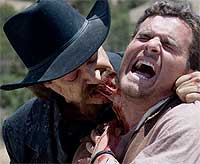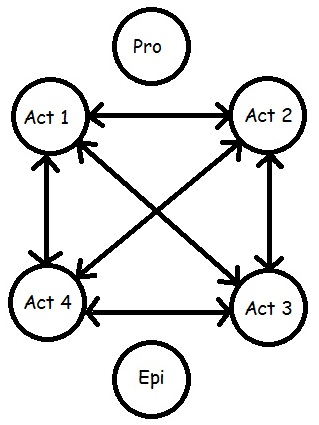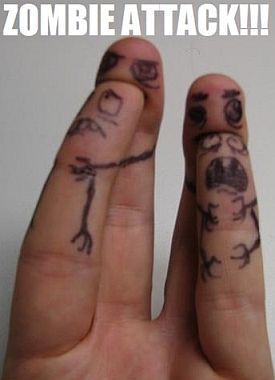The Infected
Before I continue, let’s toss out a table of contents of sorts:
Post 1: Zombie Brainstorming
Post 2: More Zombie Brainstorming!
Post 3: Of Zombies & Exploding Dice
Post 4: The History of the Plague
Next, let’s repost the rundown of infected traits:
Trait 1: The host’s lymph nodes swell into buboes. These buboes fill with a mixture of blood, pus, and live virus. Not only can they pop if roughly handled, the virus changes the host’s body so that the host can vent its buboes’ contents via the mouth and nose.
Trait 2: The infected do not respirate the way humans do. Their lungs do not serve any particular purpose. More physiological changes, however, give an infected the ability to voluntarily control its thoracic diaphragm. By contracting or relaxing this muscle, an infected can inhale or exhale, permitting it produce limited vocalizations. The infected cannot speak, except perhaps single syllable words that would be more hissed than articulated, but they can growl, moan, et cetera.
Trait 3: Further physiological changes alter bone structure and density. The proximal and distal phalanges fuse, and the fused bones grows into something very much like spikes. Since the bones are denser as a whole, the infected is more durable and less suspectible to injury.
Trait 4: The infected’s brain changes as well. It enters a hyper-adrenaline state which constantly floods the infected’s body with this powerful hormone. At the same time, the nervous system is less sensitive to pain and fatigue.
Trait 5: The infected kill and eat the non-infected because uninfected human tissues contain a variety of hormones which nourish the virus. Chief among the hormones that the infected crave are arenaline and cortisol, the hormones that trigger the flight-or-fight response.
Now with all that done, it’s time to tackle the stats of the infected. For this part of the brainstorming, I’m borrowing the idea of templates from the d20 System. For those of you not familiar with this little gem of game design, a template is a set of rules that change a base creature into a different sort of creature. The Pathfinder Roleplaying Game, for example, has a number of simple templates, such as the Giant Creature template that tells the GM how to quickly adjust a creature’s stats reflect it being bumped up in size by one category.
The Infected Template is applicable to any human. In GYFG!, there are two types of people: Folk and NPCs. The former are generic characters. They are 0-level people with average stats and maybe a special ability or two at most. NPCs are more fleshed out. They have a class, level, all six attributes, et cetera. Since NPCs are the more complicated, I’m going to start with template designed based on them.
Infected Template

The Infected Template is applied to any person who has contracted the plague and become a cannibalistic, raging psychopath.
Class & Level: The infected retain their level, Hit Dice, bonus to hit, bonus to defense, and class abilities.
Attributes: The infected gain a +4 bonus to Strength and Constitution, and a +2 bonus to Dexterity. They suffer a -4 penalty to Intelligence, Wisdom, and Charisma. No attribute may be higher than 21 or lower than 5 once these modifiers are applied. Regardless of class, Strength and Constitution are primary attributes. Dexterity is the infected’s only secondary attribute. Mental attributes are all treated as tertiary.
Hit Points: The infected’s hit points likely change due to the increase in Constitution. The infected are not rendered unconscious when their hit points are reduced to 0 or lower. An infected whose hit points are -1 or lower still loses 1 hit point per combat round from blood loss. The amount of negative hit points an infected has been reduced to is applied as a modifier to all d20 rolls the infected makes. For example, an infected reduced to -5 hit points can still move, fight, et cetera, but it suffers a -5 penalty to d20 rolls. An infected dies when reduced to -10 hit points.
Abilities: The infected often have impaired class abilities due to their adjusted attributes. They also don’t use tools, so abilities such as a gunslinger’s fast draw are almost always irrelevant. Defence Class likely changes due to the increase in Dexterity.
Languages & Literacy: The infected cannot speak properly, but they retain the ability to understand whatever languages they knew prior to infection.
Special Abilities: All infected have the following special abilities.
* Bite: The infected can bite a grappled victim with a successful attack roll. The bite inflicts 1d2 points of damage (modified by Strength), and the victim may be exposed to the virus. The victim is allowed a Dexterity saving throw to avoid exposure. Those that fail this saving throw must make a Constitution saving throw to avoid infection. Both of these saving throws are made with a +2 bonus.
* Cannot Drown: The infected do not respirate the way humans do. They cannot drown in water since they can extract needed oxygen from the water.
* Claws: The infected attack with their claws. They get two claw attacks per round that inflict 1d4 points of damage each, modified by Strength as normal.
* Vent Buboes: As an attack usable a number of times per day equal to Constitution modifier, the infected may vent their buboes via their mouths and noses. This attack has a range of 10 feet. The chosen target must make a Dexterity saving throw to avoid being sprayed. If this saving throw fails, the victim must make a Constitution saving throw to avoid infection. If this fails, the victim is almost certainly doomed.
Special Hazard: An infected reduced to -1 or few hit points presents a special hazard. Anyone adjacent (within 5 feet) of such an injured infected when that infected suffers further damage may be splashed, sprayed, et cetera, by virus-laden fluids. Those who might be sprayed must make a Dexterity saving throw to avoid being hit by bodily fluids. Those that fail this saving throw must make a Constitution saving throw to avoid infection. Both of these saving throws are made with a +2 bonus.
XP: Increase the XP value of the base creature by adding the appropriate special ability modifier twice. For example, a rowdy is normally worth 65 XP. Once infected, he is worth 105 XP.
When applying the template to a Folk, the process is simpler:
* +2 bonus to Strength and Constitution checks, and a +1 bonus to Dexterity checks.
* +2 Strength-based damage.
* +2 hit points per Hit Die.
* +1 Defence Class.
* -2 to Intelligence, Wisdom, and Charisma checks.
* Two prime attributes: Strength and Constitution.
* Apply special abilities and special hazard as normal.
Becoming Infected
Eventually, a PC or important NPC is going to get infected. Both the Dexterity and Constitution saving throws are going to fail. At this point, there is nothing to do but kill the victim before he fully succumbs to the virus. Once per combat round for the next 1d4+4 rounds after being infected, the victim may make a Wisdom saving throw. If he succeeds, he can act normally that combat round. Otherwise, he simply screams, flails about, et cetera, as the virus mutates his body and mind with horrifying rapidity. After the 1d4+4 combat rounds, the victim is fully transformed. On the plus side, he’s likely already injured, so at least killing him will be a bit easier.
 Who says teachers get the summer off?
Who says teachers get the summer off? Before I continue with my zombie brainstorms, I realized I made a boo-boo of sorts. GFYG! doesn’t grant a new Hit Die at every level, but only for the first 4 levels. For example, the brave character class grants a d10 Hit Die at each level 1 through 4 only. After that, the brave gets +3 hit points per level thereafter.
Before I continue with my zombie brainstorms, I realized I made a boo-boo of sorts. GFYG! doesn’t grant a new Hit Die at every level, but only for the first 4 levels. For example, the brave character class grants a d10 Hit Die at each level 1 through 4 only. After that, the brave gets +3 hit points per level thereafter.